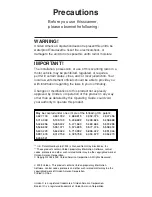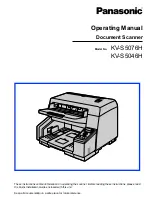
The tool will always wake up in the Low Sensitivity (1) setting .
In Low Sensitivity, the target needs to be very large or fairly close to the surface before an
indication is given . This sensitivity level is best suited for environments with high metal content .
Always perform the initial scans in the Low Sensitivity default setting . If no metal is found after
several calibration and scanning attempts, increase the sensitivity level by one level and repeat the
scanning process .
Each press of the Sensitivity button will change the sensitivity level of the unit from Low to Medium
to High and back down again (High to Medium to Low) . The tool will automatically recalibrate any
time the sensitivity level is changed .
This tool is calibrated for
1
⁄
2
in. diameter rebar and
1
⁄
2
in. diameter
copper pipe. Targets larger than
1
⁄
2
in. diameter rebar and
1
⁄
2
in.
diameter copper pipe will be indicated as being closer to the surface than actual while
smaller targets (less than
1
⁄
2
in. diameter rebar and less than
1
⁄
2
in. diameter copper pipe)
will be indicated as farther away from the surface than actual.
5. SCaNNING TIpS
• For best results, calibrate the locator away from metal and avoid wearing jewelry, including
watches, as it will interfere with the locator’s readings .
• Use the lanyard loop for easy access and added security from dropping when in high or hard
to reach areas .
• If the tool is unable to calibrate for any reason, the tool will show the letters “ERR” in the
Numeric Depth Indicator area of the display to indicate there was a calibration error . If this
happens, there is too much metal near the tool for it to calibrate properly . Move the tool to
another location and perform the calibration process again by pressing and releasing the
CAL button .
• If the tool nears a large mass of metal (the reading is too saturated), the tool may not be able
to definitively determine the center, although all the Relative Signal Strength bars may turn on
and the Numeric Depth value may turn to “00” . Please recalibrate the tool and/or move the tool
away and move back slowly .
• If the tool is calibrated too close to the target, it may indicate that there is no metal in the area
when in fact there is . To check this, calibrate the tool in several locations and compare results .
Always perform several scans of an area to confirm that the consistent results are achieved .
6. aTTaCHING/rEMoVING THE HaNDLE
While the tool can be
used with or without
the included handle
(and/or optional pole
extension), using the
handle will allow for
less interference with
the tool’s sensors,
easier range of motion,
and extended reach
and comfort .
WARNING
Low
High
Medium
5
EN
Содержание MetalliScanner x8
Страница 1: ...MetalliScanner x8 English Espa ol Fran ais...






































